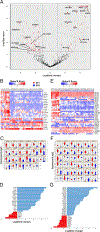Non-cell autonomous mechanism of Parkinson's disease pathology caused by G2019S LRRK2 mutation in Ashkenazi Jewish patient: Single cell analysis
- PMID: 31330122
- PMCID: PMC8152577
- DOI: 10.1016/j.brainres.2019.146342
Non-cell autonomous mechanism of Parkinson's disease pathology caused by G2019S LRRK2 mutation in Ashkenazi Jewish patient: Single cell analysis
Abstract
Parkinson's disease (PD) is the second most prevalent neurodegenerative disease, characterized by the loss of the midbrain dopaminergic neurons, which leads to impaired motor and cognitive functions. PD is predominantly an idiopathic disease, however about 5% of cases are linked to hereditary mutations. The most common mutation in both familial and sporadic PD is the G2019S mutation of leucine-rich repeat kinase 2 (LRRK2) with high prevalence in Ashkenazi Jewish patients and in North African Berber and Arab patients. It is still not fully understood how this mutation leads to PD pathology. In this study, we derived induced pluripotent stem cells (iPSCs) from an Ashkenazi Jewish patient with G2019S LRRK2 mutation to isolate self-renewable multipotent neural stem cells (NSCs) and to model this form of PD in vitro. To investigate the cellular diversity and disease pathology in the NSCs, we used single cell RNA-seq transcriptomic profiling. The evidence suggests there are three subpopulations within the NSCs: a committed neuronal population, intermediate stage population and undifferentiated stage population. Unbiased single-cell transcriptomic analysis revealed differential expression and dysregulation of genes involved in PD pathology. The significantly affected genes were involved in mitochondrial function, DNA repair, protein degradation, oxidative stress, lysosome biogenesis, ubiquitination, endosome function, autophagy and mitochondrial quality control. The results suggest that G2019S LRRK2 mutation may affect multiple cell types in a non-cell autonomous mechanism of PD pathology and that unbiased single-cell transcriptomics holds promise for personalized medicine.
Keywords: Induced pluripotent stem cells; Mitochondrial function; Neural stem cells; Non-cell autonomous pathology; Parkinson’s disease; Single cell technologies.
Copyright © 2019. Published by Elsevier B.V.
Figures






References
-
- Araki M, Nagata K, Satoh Y, Kadota Y, Hisha H, Adachi Y, Taketani S, 2002. Developmentally regulated expression of Neuro-p24 and its possible function in neurite extension. Neurosci Res. 44, 379–389. - PubMed
-
- Beilina A, Rudenko IN, Kaganovich A, Civiero L, Chau H, Kalia SK, Kalia LV, Lobbestael E, Chia R, Ndukwe K, Ding J, Nalls MA, Olszewski M, Hauser DN, Kumaran R, Lozano AM, Baekelandt V, Greene LE, Taymans JM, Greggio E, Cookson MR, Nalls MA, Plagnol V, Martinez M, Hernandez DG, Sharma M, Sheerin UM, Saad M, Simon-Sanchez J, Schulte C, Lesage S, Sveinbjornsdottir S, Arepalli S, Barker R, Ben-Shlomo Y, Berendse HW, Berg D, Bhatia K, de Bie RMA, Biffi A, Bloem B, Bochdanovits Z, Bonin M, Bras JM, Brockmann K, Brooks J, Burn DJ, Charlesworth G, Chen H, Chong S, Clarke CE, Cookson MR, Cooper JM, Corvol JC, Counsell C, Damier P, Dartigues JF, Deloukas P, Deuschl G, Dexter DT, van Dijk KD, Dillman A, Durif F, Durr A, Edkins S, Evans JR, Foltynie T, Gao J, Gardner M, Gibbs JR, Goate A, Gray E, Guerreiro R, Gustafsson O, Harris C, van Hilten JJ, Hofman A, Hollenbeck A, Holton J, Hu M, Huang X, Huber H, Hudson G, Hunt SE, Huttenlocher J, Illig T, Munchen HZ, Jonsson PV, Lambert JC, Langford C, Lees A, Lichtner P, Munchen HZ, Limousin P, Lopez G, Lorenz D, McNeill A, Moorby C, Moore M, Morris HR, Morrison KE, Mudanohwo E, O’Sullivan SS, Pearson J, Perlmutter JS, Petursson H, Pollak P, Post B, Potter S, Ravina B, Revesz T, Riess O, Rivadeneira F, Rizzu P, Ryten M, Sawcer S, Schapira A, Scheffer H, Shaw K, Shoulson I, Sidransky E, Smith C, Spencer CCA, Stefansson H, Steinberg S, Stockton JD, Strange A, Talbot K, Tanner CM, Tashakkori-Ghanbaria A, Tison F, Trabzuni D, Traynor BJ, Uitterlinden AG, Velseboer D, Vidailhet M, Walker R, van de Warrenburg B, Wickremaratchi M, Williams N, Williams-Gray CH, Winder-Rhodes S, Stefansson K, Hardy J, Heutink P, Brice A, Gasser T, Singleton AB, Wood NW, Chinnery PF, Arepalli S, Cookson MR, Dillman A, Ferrucci L, Gibbs JR, Hernandez DG, Johnson R, Longo DL, Majounie E, Nalls MA, O’Brien R, Singleton AB, Traynor BJ, Troncoso J, van der Brug M, Zielke HR, Zonderman AB, 2014. Unbiased screen for interactors of leucine-rich repeat kinase 2 supports a common pathway for sporadic and familial Parkinson disease. Proceedings of the National Academy of Sciences. 111, 2626–2631. - PMC - PubMed
-
- Berger I, Hershkovitz E, Shaag A, Edvardson S, Saada A, Elpeleg O, 2008. Mitochondrial complex I deficiency caused by a deleterious NDUFA11 mutation. Ann Neurol. 63, 405–8. - PubMed
Publication types
MeSH terms
Substances
Grants and funding
LinkOut - more resources
Full Text Sources
Other Literature Sources
Medical
Research Materials

